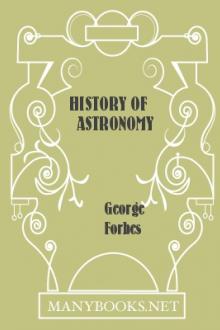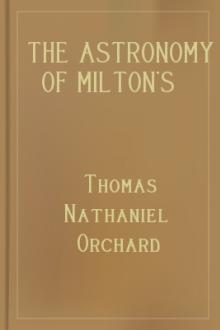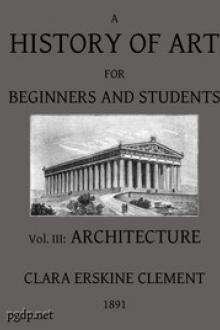History of Astronomy by George Forbes (classic children's novels TXT) 📕

- Author: George Forbes
- Performer: -
Book online «History of Astronomy by George Forbes (classic children's novels TXT) 📕». Author George Forbes
[8] Hist. of Phys. Ast., p. vii.
[9] “Est enim Astronomi proprium, historiam motuum coelestium diligenti et artificiosa observatione colligere. Deinde causas earundem, seu hypotheses, cum veras assequi nulla ratione possit … Neque enim necesse est, eas hypotheses esse veras, imo ne verisimiles quidem, sed sufficit hoc usum, si calculum observationibus congruentem exhibeant.”
BOOK II. THE DYNAMICAL PERIOD
5. DISCOVERY OF THE TRUE SOLAR SYSTEM—TYCHO BRAHE—KEPLER.
During the period of the intellectual and aesthetic revival, at the beginning of the sixteenth century, the “spirit of the age” was fostered by the invention of printing, by the downfall of the Byzantine Empire, and the scattering of Greek fugitives, carrying the treasures of literature through Western Europe, by the works of Raphael and Michael Angelo, by the Reformation, and by the extension of the known world through the voyages of Spaniards and Portuguese. During that period there came to the front the founder of accurate observational astronomy. Tycho Brahe, a Dane, born in 1546 of noble parents, was the most distinguished, diligent, and accurate observer of the heavens since the days of Hipparchus, 1,700 years before.
Tycho was devoted entirely to his science from childhood, and the opposition of his parents only stimulated him in his efforts to overcome difficulties. He soon grasped the hopelessness of the old deductive methods of reasoning, and decided that no theories ought to be indulged in until preparations had been made by the accumulation of accurate observations. We may claim for him the title of founder of the inductive method.
For a complete life of this great man the reader is referred to Dreyer’s Tycho Brahe, Edinburgh, 1890, containing a complete bibliography. The present notice must be limited to noting the work done, and the qualities of character which enabled him to attain his scientific aims, and which have been conspicuous in many of his successors.
He studied in Germany, but King Frederick of Denmark, appreciating his great talents, invited him to carry out his life’s work in that country. He granted to him the island of Hveen, gave him a pension, and made him a canon of the Cathedral of Roskilde. On that island Tycho Brahe built the splendid observatory which he called Uraniborg, and, later, a second one for his assistants and students, called Stjerneborg. These he fitted up with the most perfect instruments, and never lost a chance of adding to his stock of careful observations.[1]
The account of all these instruments and observations, printed at his own press on the island, was published by Tycho Brahe himself, and the admirable and numerous engravings bear witness to the excellence of design and the stability of his instruments.
His mechanical skill was very great, and in his workmanship he was satisfied with nothing but the best. He recognised the importance of rigidity in the instruments, and, whereas these had generally been made of wood, he designed them in metal. His instruments included armillae like those which had been used in Alexandria, and other armillae designed by himself—sextants, mural quadrants, large celestial globes and various instruments for special purposes. He lived before the days of telescopes and accurate clocks. He invented the method of sub-dividing the degrees on the arc of an instrument by transversals somewhat in the way that Pedro Nunez had proposed.
He originated the true system of observation and reduction of observations, recognising the fact that the best instrument in the world is not perfect; and with each of his instruments he set to work to find out the errors of graduation and the errors of mounting, the necessary correction being applied to each observation.
When he wanted to point his instrument exactly to a star he was confronted with precisely the same difficulty as is met in gunnery and rifle-shooting. The sights and the object aimed at cannot be in focus together, and a great deal depends on the form of sight. Tycho Brahe invented, and applied to the pointers of his instruments, an aperture-sight of variable area, like the iris diaphragm used now in photography. This enabled him to get the best result with stars of different brightness. The telescope not having been invented, he could not use a telescopic-sight as we now do in gunnery. This not only removes the difficulty of focussing, but makes the minimum visible angle smaller. Helmholtz has defined the minimum angle measurable with the naked eye as being one minute of arc. In view of this it is simply marvellous that, when the positions of Tycho’s standard stars are compared with the best modern catalogues, his probable error in right ascension is only ± 24”, 1, and in declination only ± 25”, 9.
Clocks of a sort had been made, but Tycho Brahe found them so unreliable that he seldom used them, and many of his position-measurements were made by measuring the angular distances from known stars.
Taking into consideration the absence of either a telescope or a clock, and reading his account of the labour he bestowed upon each observation, we must all agree that Kepler, who inherited these observations in MS., was justified, under the conditions then existing, in declaring that there was no hope of anyone ever improving upon them.
In the year 1572, on November 11th, Tycho discovered in Cassiopeia a new star of great brilliance, and continued to observe it until the end of January, 1573. So incredible to him was such an event that he refused to believe his own eyes until he got others to confirm what he saw. He made accurate observations of its distance from the nine principal stars in Casseiopeia, and proved that it had no measurable parallax. Later he employed the same method with the comets of 1577, 1580, 1582, 1585, 1590, 1593, and 1596, and proved that they too had no measurable parallax and must be very distant.
The startling discovery that stars are not necessarily permanent, that new stars may appear, and possibly that old ones may disappear, had upon him exactly the same effect that a similar occurrence had upon Hipparchus 1,700 years before. He felt it his duty to catalogue all the principal stars, so that there should be no mistake in the future. During the construction of his catalogue of 1,000 stars he prepared and used accurate tables of refraction deduced from his own observations. Thus he eliminated (so far as naked eye observations required) the effect of atmospheric refraction which makes the altitude of a star seem greater than it really is.
Tycho Brahe was able to correct the lunar theory by his observations. Copernicus had introduced two epicycles on the lunar orbit in the hope of obtaining a better accordance between theory and observation; and he was not too ambitious, as his desire was to get the tables accurate to ten minutes. Tycho Brahe found that the tables of Copernicus were in error as much as two degrees. He re-discovered the inequality called “variation” by observing the moon in all phases—a thing which had not been attended to. [It is remarkable that in the nineteenth century Sir George Airy established an altazimuth at Greenwich Observatory with this special object, to get observations of the moon in all phases.] He also discovered other lunar equalities, and wanted to add another epicycle to the moon’s orbit, but he feared that these would soon become unmanageable if further observations showed more new inequalities.
But, as it turned out, the most fruitful work of Tycho Brahe was on the motions of the planets, and especially of the planet Mars, for it was by an examination of these results that Kepler was led to the discovery of his immortal laws.
After the death of King Frederick the observatories of Tycho Brahe were not supported. The gigantic power and industry displayed by this determined man were accompanied, as often happens, by an overbearing manner, intolerant of obstacles. This led to friction, and eventually the observatories were dismantled, and Tycho Brahe was received by the Emperor Rudolph II., who placed a house in Prague at his disposal. Here he worked for a few years, with Kepler as one of his assistants, and he died in the year 1601.
It is an interesting fact that Tycho Brahe had a firm conviction that mundane events could be predicted by astrology, and that this belief was supported by his own predictions.
It has already been stated that Tycho Brahe maintained that observation must precede theory. He did not accept the Copernican theory that the earth moves, but for a working hypothesis he used a modification of an old Egyptian theory, mathematically identical with that of Copernicus, but not involving a stellar parallax. He says (_De Mundi_, etc.) that
the Ptolemean system was too complicated, and the new one which that great man Copernicus had proposed, following in the footsteps of Aristarchus of Samos, though there was nothing in it contrary to mathematical principles, was in opposition to those of physics, as the heavy and sluggish earth is unfit to move, and the system is even opposed to the authority of Scripture. The absence of annual parallax further involves an incredible distance between the outermost planet and the fixed stars.
We are bound to admit that in the circumstances of the case, so long as there was no question of dynamical forces connecting the members of the solar system, his reasoning, as we should expect from such a man, is practical and sound. It is not surprising, then, that astronomers generally did not readily accept the views of Copernicus, that Luther (Luther’s Tischreden, pp. 22, 60) derided him in his usual pithy manner, that Melancthon (_Initia doctrinae physicae_) said that Scripture, and also science, are against the earth’s motion; and that the men of science whose opinion was asked for by the cardinals (who wished to know whether Galileo was right or wrong) looked upon Copernicus as a weaver of fanciful theories.
Johann Kepler is the name of the man whose place, as is generally agreed, would have been the most difficult to fill among all those who have contributed to the advance of astronomical knowledge. He was born at Wiel, in the Duchy of Wurtemberg, in 1571. He held an appointment at Gratz, in Styria, and went to join Tycho Brahe in Prague, and to assist in reducing his observations. These came into his possession when Tycho Brahe died, the Emperor Rudolph entrusting to him the preparation of new tables (called the Rudolphine tables) founded on the new and accurate observations. He had the most profound respect for the knowledge, skill, determination, and perseverance of the man who had reaped such a harvest of most accurate data; and though Tycho hardly recognised the transcendent genius of the man who was working as his assistant, and although there were disagreements between them, Kepler held to his post, sustained by the conviction that, with these observations to test any theory, he would be in a position to settle for ever the problem of the solar system.
[Illustration: PORTRAIT OF JOHANNES KEPLER. By F. Wanderer, from Reitlinger’s “Johannes Kepler” (original in Strassburg).]
It has seemed to many that Plato’s demand for uniform circular motion (linear or angular) was responsible for a loss to astronomy of good work during fifteen hundred years, for a hundred ill-considered speculative cosmogonies, for dissatisfaction, amounting to disgust, with these à priori guesses, and for the relegation of the science to less intellectual races than Greeks and other Europeans. Nobody seemed to dare to depart from this fetish of uniform angular motion and circular orbits until the insight, boldness, and independence of Johann Kepler opened up a new world of thought and of intellectual delight.
While at work on the Rudolphine tables he used the old epicycles and deferents and excentrics, but he could not make theory agree with observation. His instincts told him that these apologists for uniform motion





Comments (0)